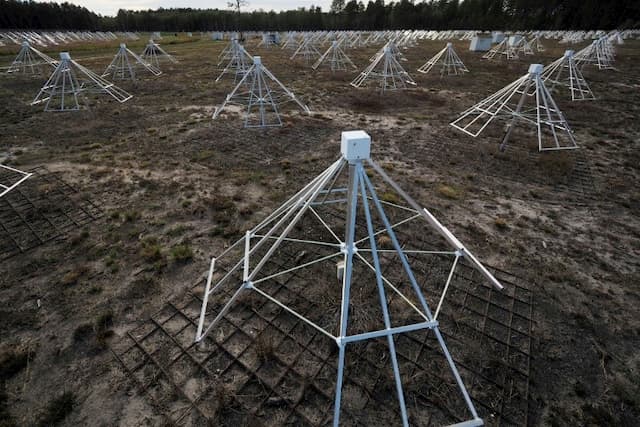In the Heart of Sologne, the Distant Ages of the Universe Murmur Low Frequency

This curious instrument called NenuFAR, inaugurated Thursday 3rd October 2019 with great pomp, comes to enrich the park of the new generation of radio telescopes.
It is here that the cosmic dawn is being surveyed: NenuFAR, a state-of-the-art radio telescope, nestled in the heart of France in the heart of the Sologne forest, began to write the history of the Universe in its infancy thanks to an ultra-sensitive system for detecting very low frequencies.
When entering the radio station of Nançay, the visitor is asked to activate the airplane mode of his phone in order to respect the “radio silence” which reigns on the site, thanks to the trees which screen against the parasites coming from the horizon.
A huge clearing, totally isolated, where stands the Grand Radiotelescope inaugurated by De Gaulle in 1965, and at his side, a field of almost 2000 small fixed antennas, similar to umbrella whales.
“Ignorant about the very young Universe”
This curious instrument called NenuFAR, inaugurated Thursday 3rd October 2019 in great pomp, comes to enrich the park of the new generation of radio telescopes that probe the low frequencies, the field still little explored and whose scientists hope major discoveries to unravel the mysteries of the A distant and primordial universe.
“It’s crazy what we are ignorant about the very young Universe … We have to find! Enthused, Jocelyn Bell, a British astrophysicist known to have discovered the first pulsar (a dead star that turns on itself).

The Universe is composed mainly of hydrogen, which emits frequencies. As the Universe is expanding, the space between objects is expanding, and the wavelengths are stretching. The more we go back in the past, the longer the signals emitted by the hydrogen, the lower their frequencies.
The first instrument to cover medium and low frequencies, LOFAR, born in the 2000s in the Netherlands, today covers a spectrum at frequencies from 30 to 250 MHz (megahertz). NenuFAR, which is connected to LOFAR’s antenna array, is capable of detecting frequencies between 10 MHz and 87 MHz, ie below the FM band.
Either the lowest that can be captured on the ground – if you want to go even lower, you have to go into space or on the moon.
First stars
This ultimate sensitivity thus promises to trace the history of hydrogen in the Universe and to observe the cosmic dawn, an unknown period located about 600 million years after the Big Bang (there are 13.8 billion years), where the first stars were lit in the first galaxies, well before the formation of the first planets.
“If I look at a class of students, it’s like having a way of going back in time and seeing them at different times in their lives; or as if an archaeologist could see an image of the ancient city of Pompeii, “analysis Stéphane Corbel, director of the station of radioastronomy of the Observatory of Paris in Nançay.
“Astrophysics allows to observe at different wavelengths, and thus to have a temporal evolution of objects, which leave traces always active in space.”

“I hope to detect the radio signal of exoplanets”
Scientists anticipate many more discoveries thanks to NenuFAR, which has been working on some fifteen projects since the start of its observations last July.
“I hope to detect the radio signal of exoplanets (planets outside the solar system, NDLR), which will give access to their magnetic field, the possibility of housing life, interactions with their stars …”, explains Philippe Zarka, Scientific Director of NenuFAR and Research Director of the CNRS.
“One could also perhaps observe lightning storms on Venus, which would answer the controversy – currently some studies say there are some, others not.”
A specialized receiver should finally participate in the search for extra-terrestrial intelligence in the SETI (Search for Extra Terrestrial Intelligence) program.
NenuFAR, whose scientific observations began in July, is expected to deliver significant first results by the end of 2019.

Enjoyed this? Get the week’s top France stories
One email every Sunday. Unsubscribe anytime.


